A Paipo Interview with John Mellor
July 14, 2012 - Los Osos, California (USA)
E-mail Interview by Bob Green
John's introduction to surfing in the mid-1960s, is similar to that of
many others. However, he has also spent much of his life making and
riding a wide variety of surfcraft, including bellyboards. His
preference is for for wider, higher flotation style boards. He talks
both about surfing and making boards, including his interest in hoop
fins.
|
1. When and where did you
start surfing?
If bodysurfing and mat surfing count, I guess I got started at Santa
Monica Beach in Southern California. My mom used to hand us a few bucks
and drop my younger brother and me off at Sorrento Grill for the day.
We'd ride the mats straight in - over the falls, "Straight Off Adolph"
style (over the falls and straight in with the whitewater) and have the
time of our lives. I can still remember bombing over the falls
side-by-side and each of us grinning ear-to-ear. On real surfboards, I
think my older brother helped get me started on one of his mid-1960s
longboards. That, or a friend who had a beach house down in Hermosa
Beach. It took the two of us (one at each end) to lug his dad's giant
Jacobs, seven blocks down the hill to the beach where we would take
turns riding straight in until the fin dragged. |
|

John Mellor, ca. 2009.
Photo by Rod Rodgers.
|
Did prone surf craft feature in these early days?
In the earliest days, that's pretty much all we did. When the Boogie
boards came out, I tried those. I experimented with turning them upside
down and bending the rocker in to them. In retrospect, I should have
paid more attention to Boogies. It is more obvious to me now that they
are fantastic surfcraft.
2. Have you had much exposure to bellyboards/paipos over
the years?
Not all that much really. I'd seen the Newport Paipo ads and was
familiar with bellyboards from surf movies and magazines but didn't
really have much interest in riding them myself. Kneeboards were
slightly more popular than bellyboards but even those were pretty rare
around where I grew up.
3. When did you make your first board? Why did you want
to make a board and what was the story behind this board?
I was in Junior High School. I stripped the
glass off an old board, cut and reglued the nose to approximate the
kicked rockers that were in fashion at the time and glassed it with an
absolute disaster of an abstract pattern. The drips were about ¼" thick
and the fin which I had made delaminated. I eventually took a shovel
and literally hacked it to pieces. There were no websites or
instructional videos back them and I had never seen a board being made.
I must have been caught up in the media glorification of shapers and
thought it would be "cool." I don't know what I was thinking… it was a
total joke!
4. What is your design "philosophy?"
I don't have a specific philosophy. If I'm making a board for someone,
I do try to appreciate what it is they are trying to tell me. There can
be miles of separation between what a customer thinks it is that he is
explaining and what a shaper thinks it is that he is understanding.
Closing that gap is really what it's all about. As more surfers become
aware of and capable of using some of the design software available,
there will be fewer disappointments. It would also help if surfers in
general paid more attention to what it is they're riding….
quantitatively. If you are happy riding an off the rack board, fine. No
need to burden yourself with numbers or custom designs. For some, there
are no appropriate boards available off the rack. Those are the guys
who need to hone in on some details. It is much easier for a shaper to
understand numbers rather than vague references to things like "soft
rails" or "relaxed rocker." That's where the design software could
really bridge some gaps.
One of my main abilities is to bounce ideas back and forth with someone
and eventually get a feel for what it is that they want. My shaping
skills aren't anything special - I will however go out on a limb and not
look back when it comes to criticism by the trend followers. I know
I've made a few odd ones upon special request. I don't turn away an
order because finding the right blank will be a hassle or I don't have
it in stock. I also don't try to steer an order towards something I
already have. If it's something really "out there," we find a way to
procure or make a blank that will work.
That's basically how I've ended up building 12'6" x 27" x 5'1/2"
longboards and 6'3" x 29" bellyboards and various boards in-between.
They're often extreme custom designs and I don't worry about them
sitting in some showroom wondering if they're gonna sell.
John sliding along on a 5'10" vacuum-bagged bamboo
veneer/carbon fiber bellyboard at a remote California location. The
super wide tail and full volume allow easy take-offs and deliver plenty
of speed. Little rider input is required to get it to scoot right
along.

Photo courtesy of Jeff Chamberlain.
Two boards built by John Mellor for Jeff Chamberlain.
|

|
(Left) The acid splash board is from a Clark Foam "fish blank." It has a slight forward
belly with a big single concave and reverse rocker through the tail. It
was setup for twin keels or a hoop fin. Approximate dimensions are 5'6" x
24".
Photo courtesy of John Mellor.
(Right) This board is made from a custom-widened US Blanks plug. They were kind
enough to glue in two strips of foam to widen the blank. It has
essentially the same bottom contours as the acid splash board: belly
forward/high rails transitioning to a full single concave and hard down
rails in the tail. The board is 6'3" x 29".
Photo courtesy of Jeff Chamberlain.
|

|
Slicing offsets from 2 blanks and re-gluing them together has solved
some recent issues with bellyboards and SUPs. I've also been known to
raid dumpsters and snag SUP offcuts or broken longboards that might fit
a design. I don't know when Al Merrick came out with his Dumpster Diver
model but I may have beat him to it a long time ago. My first real
template was a throwaway I found in Greg Liddle's dumpster behind his
shop on Ventura Blvd., in Reseda. I took it home and cleaned it up a bit
and it turned out to be a decent enough board for a first time blank
shape.
Two blanks joined to form an ultra wide blank for shaping a larger than normal board (i.e., greater than 26 inches).
|
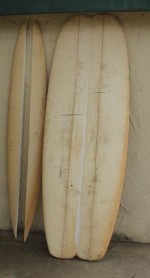
|
|
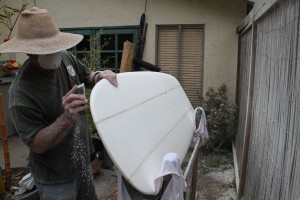
Jeff Chamberlain commenting on the buidling of his ultra wide paipo board, "To get my board
shaped, at the size it comes in at around 29 inches, John had to "join" two 8'-3" ‘hybrid’
Clark foam blanks. It was a true bear of a project to cut those slivers
off of them, and then "mate" the two blanks together perfectly. John
made it so the "glue line" is perfectly dead center in the "new blank."
|
Photos courtesy of Jeff Chamberlain.
I'd also tried stripping and cutting down old longboards. You don't
want to know how many or what they really were... but one I bought for
five dollars, had a Hobie label and was pigmented over balsa. I left it in a
friend's garage when I went in the Air Force back in 1975, and when I
got out, the blank had been reshaped, glassed and was a lovely tabletop
in my friend's wife's shop.
5. I came across a 2004 Swaylocks post where you replied
to a question regarding why you used a paipo to test a hoop fin. Does this post
still reflect your thinking about paipo?
HAHA - I just read that and all I can say is I must have been in an
argumentative mood. It's all good.
[See Note 1.] Pictured below are some examples of hooped fins..
Hoop fins under
construction. Pegs on the left and taped paper templates as a
"conceptual design" on the right.
|

|
|

|
Photos courtesy of John Mellor.
6. On the surface a bellyboard/paipo can look similar to
a small surfboard. From your perspective what differences in design are
there between a bellyboard and a stand-up board?
Well… the areas where pressure is applied to accomplish tasks such as
turning and trimming really aren't that far apart when comparing
bellyboards and surfboards. The main difference is how that pressure is
applied. In the case of bottom turning, a surfer uses his feet while on
a prone board the rider uses his belly. The prone rider can extend his
legs off the aft end, drag a fin, drag an arm, grab the forward rails
and yank the thing around, etc. The surfer relies on foot position,
body English and being able to weight/unweight by bending and
extending the legs. The hydrodynamics are very similar. Most anyone can
readily ride a surfboard on his belly and that really tells the tale.
Some guys specifically ride longer prone boards to avoid having to wear
flippers. A guy named Roger Kelly (known as "Proneman" on the paipo forums) is an excellent surfer and
chooses to ride in this fashion. He is the first to admit that his
paipo boards are quite functional as stand-up boards. Things like
planing area, rocker, foil and fin design can all be fine-tuned, of
course, but generally speaking, there are a lot of similarities.
Jeff Chamberlain throwing up spray on a long bottom
turn on the 6'3" x 29 pictured above.

Photo courtesy of John Mellor.
On the prone/stand-up design differences... the deck areas that receive
pressure while being ridden are a bit different so things like rocker
apex can be different but doesn't necessarily have to be. I think most
prone riders would agree that the front of the pelvis (while the back
arched) is where most of the pressure is applied when doing a bottom
turn for instance. If you look at the foot placement of a stand-up
shortboard rider, the pressure points are directly under the feet with
some fore/aft variability between 'rear foot' and 'front foot' styles.
Of course longboarders often move around a lot to enhance trimming or
turning mechanics.
All things considered, the back foot placement of a stand-up rider
approximates the frontal pelvic area placement of a prone rider. The
stand-up rider has the leverage advantage - he can lean/twist/turn with
his body and weight/unweight ("pump") his legs for maximum advantage.
The prone rider has a few advantages though as well... using legs as
cantilevers, he can shift weight off the aft end of the board. By
gripping the forward rails, he can push or pull the board around.
Dragging a flipper or bending the knees induces drag or gets the legs
out of the water, etc.
I think the best way to compare is to simply get out and ride a
surfboard prone. I'd go so far as to say that most people can handle a
surfboard prone pretty easily. Guys like Proneman say his El Paipo
Grande is a decent rider when standing up. The thing that sets Roger
apart from most prone riders is he doesn't wear flippers and relies on
arm power for paddling.
El Paipo Grande
and Proneman.
|

|
|

|
Photos courtesy of Roger Kelly and Brittany.
Once you get over having to have your legs in the water to engage
flippers, you've solved the balance thing that riders of longer prone
devices experience. I've seen
bellyboards from Hawaii that have massive cutaway/arced tails… I think
that could be a way to get one's legs and flippers in the water while allowing the
rider to shift his weight forward on a longer board to enhance trim. On
my longer bellyboards I've found that hanging my legs off the tail
while kicking causes the front end to be too far out the water. On
future designs, I will likely be exploring the cutaway tails along the
lines of the Hawaiian designs I've seen.
A Big Island (Hawaii) Gus Acosta Wave Arrow paipo with cut away tail.
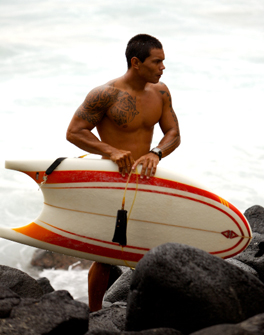
Photo courtesy of Gus Acosta.
7. If you were to build a paipo for yourself what would
it be like? Finned or finless?
Since I'm a fairly big guy, I like a board that can actually be
paddled. My last one was 5'10" x 24" x 3"… with a lot of volume -
certainly more than most shortboards of today. Finned - either twin
keels, quad, or hoop.
What sort of conditions would it be made for?
I like my boards to be functional in pretty much any conditions I'm
likely to encounter… from crappy local beachbreak to peeling walls. I
have found over the years that in good surf, there is a lot of
equipment that works just fine so I don't really sweat too many
details. The trick is finding the good waves! Night surfing is one way
I've been able to prone ride good uncrowded waves and not worry about
getting run over by surfers.
8. I'm interested in your thoughts on designs to
maximise speed and the relation to lift and attack angles?
There are always compromises in board design
in general. Some of the fastest equipment was the least forgiving. A
flat rocker can be very fast on a nice smooth face but is tricky on
late takeoffs and can get 'slap-happy' in chop. Some belly or spoon can
smooth out chop and allow the rider to roll over on the rail but in my
opinion, can slow the board down when dropping around a section and
trying to ride out on the flats. Concaves are fun and create lift. I've
done two boards for a friend that include a slight belly forward with
uplifted rails with a big single concave through the tail and hard down
rails. The first was a single fin and the second will have twin keels.
The first seemed to work really well but the second isn't complete so
time will tell. I've also done some slightly reversed tail rocker
(think airplane wing flaps) with a single concave in an effort to
enhance speed and early takeoffs. A straight edge at zero center
reveals tail rocker but at the very end, there will be a little light
showing between a straight edge and the stringer.
9. Have you continued work on the hoop fins? Any other
design directions you are pursuing?
Hoops are always fun if for no other reason
than they freak people out. In my opinion, they are perfectly
functional but for one obvious drawback… they catch kelp. I like to
place my finboxes/plugs so they can accommodate a hoop or twins to fit
different conditions. In overall bellyboard design, I'd say that there
is room for experimentation with extra width and length. The riders of
Stand-Up Paddleboards really opened my eyes to that. I've shaped some
big longboards that fit the SUP profile and have had some excellent
feedback with those designs. Bellyboards could possibly benefit from
similar explorations in sizing… not SUP size but bigger than has been
the more or less "standard" for the past 50 years. The Hawaiian Paipo
Designs "guitar pick" boards are up to 32" wide. The standard
bellyboards being shaped are generally around 22 ½"-24".
Still dripping
wet gloss coat and John's first carbon hoop. The fin mold was a 5
gallon paint bucket.
|
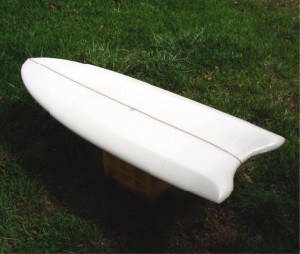
|
|

Dimensions:
5' x 22 1/2" x 16 1/2" (N) x 22" (T).
The tail tips are 20 1/2" apart.
|
John described this board in a posting several years ago on Nels Norene's Vagabondsurf.com website: The
board was made from a broken Pearson longboard that was scavanged out
of the dumpster at Morro Strand State Beach in Morro Bay. He states, "I
haven't fine tuned the template or anything - I just hacked out one
side from what was left of the foam and crudely measured to the other
side to try and get some symmetry. It still needs some work but I'm
hoping that I can finish it off with some hooked twin fins and use it
as a bellyboard. It has a slightly concave deck." Additionally, "Rocker
is pretty flat but I don't have the numbers. As I mentioned, I just
winged it by hacking out one side after I stripped off the old glass.
After smoothing it out with a long flexible sanding block, I measured
across to fill in the template on the other side. With my angled
rectangular hook fins, I think it will be a screaming bellyboard." |
Photos courtesy of John Mellor.
|
5'10" carbon
vacuum-bagged bamboo veneer.
|

|
|

|
"The blank was a SUP deck offcut that I
flipped over, cut a slice down the center and glued in a partial
stringer to get some nose rocker out of it. Another "Dumpster Diver" I
suppose. I was pleased with the speed on this one but the length made
it difficult to get my legs in the water while paddling without tilting
the nose up. That's exactly the type of board on which I think the deep
arc tail would be of benefit. I didn't put a leash attachment on it but
now wish I had! I had on my UDT fins and lost it against some gnarly
rocks. By the time I swam in, got the fins off, and scrambled to
retrieve the board, it was pretty much toast." |
Photos courtesy of Jeff Chamberlain.
10. I see that you bought one of Mike Shourds's wood paipo
boards and that you have built chambered boards. Do you surf wood boards much?
Aside from some stringer inserts, vacuum bagged veneers, and a couple
of solid Balsas, I haven't really done any wood boards. I haven't done
any of the plank on frame boards that have seen some renewed interest
recently. I've ridden one of my solid balsa boards a few times but it's
pretty darn heavy!
Any comments on how wood paipos ride or compare with
foam boards?
I'm kind of spoiled by thicker boards that float. If I were to choose
between being a "slab" guy or a "spoon' guy," I'd say I'm more of a slab
guy. Kneeboarders will know what I'm talking about.
Wood paipo by Mike Shourds
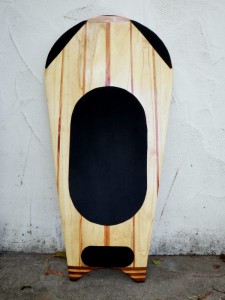
Photo courtesy of John Mellor.
11. I believe you still ride surf mats as well. What do
you enjoy about mats?
Oh, mats are great fun! Everything you've heard about them is true. I
find that with my size, I need a certain size wave to get them going
but once that size threshold has been crossed, they can be a gas. The
key points I like to remember with mats, aside from the actual ride, is
the portability and the comfort. You can easily stuff one in a pack and
travel anywhere with one. The bumps I get on my ribcage from a surfboard or a fiberglassed prone
board disappear after
riding a mat for awhile. To view the real potential of a mat, check the online videos of
Mark Thompson or George Greenough. Those will tell you much more than I
can and certainly more than I can demonstrate.
Greenough has spent a lifetime or two riding mats.
What do you like about surfing a mat?
On my best mat rides, a certain wave size threshold was reached and the
mats I've ridden just seemed to take off. Little input from the rider
is needed. In fact, as some of the manufacturers have claimed, "less is
more" when it comes to rider input. I've found the take-off position
and angle seem key to successful rides. Once the angle is established
and the initial line is drawn, you're pretty much there. The lack of
acrobatics required and the comfort level experienced seem out of whack
compared to the final result. If an "effort/reward ratio" could be
calculated, it would be an interesting fraction...
John
Mellor carving under the lip on second hand Neumatic surf mat during a
surf mat/flex spoon get together in Santa Cruz, called "The Dale," ca.
December 2006.

Photo courtesy of John Mellor and photographer Joel Mayer.
12. I imagine you have an interesting choice of boards
to ride. What determines which surfcraft you ride on any given day?
A lot of the boards in my pile have been put on the back burner and are
kept around mostly as reference material. There always seems to be a
new project brewing and those new boards seem to get most of my
interest when completed. The conflict arises as I try to figure out
where the "buttons" are even while imagining the next series of
improvements. It's a fine line determining when I've actually given a
new board enough time to have figured it out and when it's time to move
on. Of course there will always be some "Golden Oldies" that are worth
pulling out when the mood strikes.
I've made and ridden several different designs. I have ridden a Hawaiian Paipo
Design "Guitar Pick" I owned. I have also ridden Roger Kelly's (Proneman) Paul
Gross Aquaplane from which I still have the nose/tail offcuts he gave
me, Chamberlain's PHD twin fin model, etc.
Paul Gross Aquaplane with blank

Photo courtesy of Jeff Chamberlain.
I generally don't try to limit myself to any particular board type or
design - I have a pile of inflatable mats and a bigger pile yet of
surfboards. As I've gotten older, I mostly surf big longboards. They
paddle much better and are generally more forgiving as I become slower
and less "athletic" in my riding style. I find myself surfing more on
the "in-between" days. Many people past 50-years-old can likely relate. Heck,
many people past 30 or 40 have given it up due to injuries or whatever.
13. Any waves or surfs on a paipo board that stand out for you
over the years?
Oh yeah… A couple of years back, I was out on an experimental hoop fin
model and a sneaker set caught me by surprise in position for a late
take-off. Some of my friends were inside of me and as much as I'd like
to say I don't surf for an audience, it was a kick to have them see me
make that wave. I've also been a deckhand on a friend's boat and as a
result of that relationship have had a number of memorable prone surfs.
Bellyboard
streaking
|

|
|

|
Photos courtesy of Jeff Chamberlain.
14. Any other comments?
Just a big thank you for taking the time to
set up this interview. I have learned so much from reading the past
interviews with other shapers and riders.
Hoop fin turning
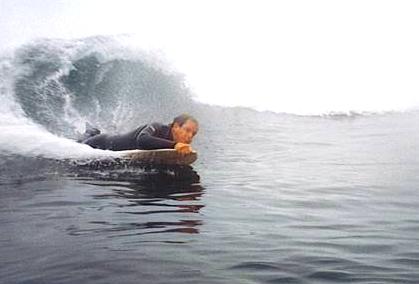
Photo courtesy of Jeff Chamerlain.
|
Note 1: For the full Swaylocks discussion about choosing a paipo board as a choice to test out hoop fins click here. John Mellor's response to Keith is below:
1. Because they're really fun and probably more forgiving when experimenting with a totally new fin design.
2.
When you ride on your belly, as any mat or bodyboarder can tell you,
your face is close to the water and it seems like you're
going that much faster.
3. You can get tubed like nobody's business on one.
4. It's a good way to make use of broken boards.
5. If the fin design doesn't work, you can drag a swim fin in the water and still keep control.
6. If
it does work, you can arch your back, lift your legs and feel what the
board and fins are actually doing on their own.
7. If you fall, you don't fall as far.
8. Showing up at the beach with something no one has seen before is kind of fun.
9.
Hopefully, it gets people on this site brainstorming away from retro
30-40 year old recycled ideas that have come and gone
and are back again.
10. If anything new is gonna happen in the way of design, somebody has to take a chance.
11. Why not? |
|